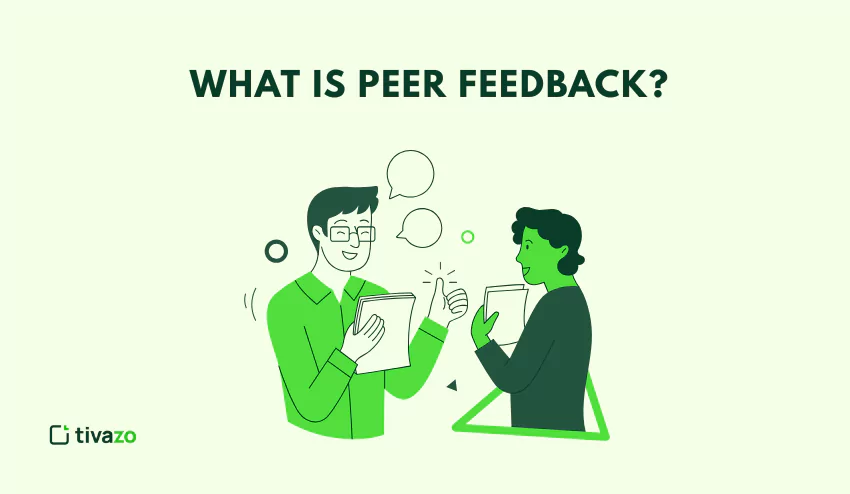As a team leader, your main role is to lead and empower your team to achieve the best work possible. Team members work more efficiently when they feel comfortable with each other, but when they struggle to mesh, it can hinder progress.
In order for your team to operate at its highest ability, you must understand the 5 Stages of Group Development. Coined by psychologist Bruce Tuckman to assist team leaders in guiding their team through each stage, this model provides a framework to help. In this article, we will introduce you to the 5 Stages of Group Development and how you can appropriately guide your team as it progresses through the stages, which will benefit group collaboration and overall success.
Key Highlights:
- What Are the 5 Stages of Group Development
- Stages of Group Development
- Key Challenges in Group Development
- Guide Your Team Through the 5 Stages of Group Development
- Measure Team Progress Through the 5 Stages of Group Development
What Are the 5 Stages of Group Development?
The 5 Stages of Group Development, according to Bruce Tuckman, are a natural progression teams go through to develop from strangers to a unit that is able to perform at a high rate. Each stage of development is unique, and each stage requires different leadership styles and group dynamics. Below is a breakdown of the stages:
- Forming
- Storming
- Norming
- Performing
- Adjourning
Knowing these stages can help leaders provide the appropriate level of support at the appropriate time, leading to improved transitions and collaboration among team members.
Stages of Group Development
Knowing about the 5 Stages of Group Development is important to assist in leading your team from strangers to a high-performing unit. These stages describe the development of your team and how you, as a leader, assist and lead in that process. Let’s break this down step by step.
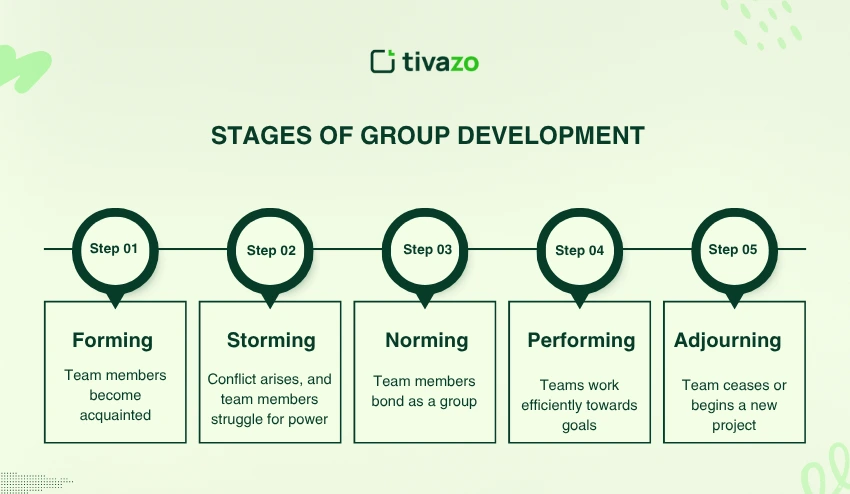
1. Forming – Getting to Know Each Other
The Forming stage is like the first model at school for the team that collectively comes together. Everyone will become acquainted, assigned roles, and figure out the overall goals of the team. This is where some of the relationship building and forming the foundation begins to come into play for future success.
Characteristics:
- Team members are typically polite yet unsure about each other.
- There is uncertainty regarding team roles and what each member’s contribution will be.
- The group is focused on organizing and figuring out the overall goals.
- Team members are still building relationships and figuring out how to work together.
Pro Tip:
- As a leader, provide an oasis of guidance, starting expectations early on, and encourage team-centric activities to facilitate interactions and assist members in engaging with one another.
2. Storming – When the Tension Builds
The Storming stage occurs when the team is about to face some sort of conflict or dilemma. Individual team members are starting to feel satisfied in their team roles and are beginning to question and challenge either a team member’s thoughts or values and share their unbiased opinion. The storms can feel intense, though this type of conflict is a normal developmental step for teams and is necessary.
Characteristics:
- Team members are starting to freely share their opinions, which can lead to disagreements.
- Power struggles and role confusion may contribute to frustration.
- Team dynamics might seem a bit chaotic or disorganized while members manage their differences.
- Tension can arise from differences in working styles, perspectives, and personalities.
Pro Tip:
- Attempt to promote openness and foster conflict as a means of improvement. Use team conflict to develop problem-solving skills and build the team’s collaborative capability overall.
3. Norming – Settling Into a Groove
At the Norming stage, things will begin to settle down. The team will begin to find trust, define roles, and establish norms for collaborating effectively, as the conflict will be behind them, and will begin to focus on working more cohesively and productively.
Characteristics:
- Team members are beginning to work together more effectively.
- Roles and responsibilities will become clearer.
- Team members begin to trust each other and will experience better communication.
- Team norms and ways of working together will appear.
Pro Tip:
- Let team members begin to take ownership of their own tasks and encourage positive feedback, and that will help it gain traction. Celebrate small victories to promote team engagement.
4. Performing – Team at Its Best
When the team reaches the Performing stage, they will be operating at a high functioning level. They will be working toward common goals and working toward a common high level of teamwork. There will be significant trust between the members, and it will become all about execution.
Characteristics:
- Team members start to become self-starters and leaders.
- The team starts to show great cooperation with little direction from the team leader when working toward the same goals.
- Roles are defined and highly productive.
- There is a sense of purpose, and the team feels some empowerment.
Pro Tip:
- Keep the momentum high by continuing to provide strategic leadership – back off from micromanaging and enable an environment that allows the team to succeed on its own, while also recognizing their good outcomes.
5. Adjourning – Wrapping Up and Moving On
At the Adjourning stage, the team has finished its work and is moving on to a new project or disbanding itself. It’s time to reflect and celebrate work as the team stops to recognize everything they accomplished and get ready for future adventures, whatever they may be.
Characteristics:
- The team has tied up its purposeful activities and is examining the journey so far.
- The team members have experienced a sense of accomplishment or closure.
- Some team members will feel desirous or sadness because the team is about to disband.
- Some will want to celebrate and recognize everyone’s contributions.
Pro Tip:
- Take your time to recognize the accomplishments of everyone, provide closure, and make sure every team member feels valued and appreciated for their efforts.
What Are the Key Challenges in Group Development?
As teams navigate the course of the 5 Stages of Group Development, the potential for encountering numerous obstacles exists that could ultimately impede progress if they are not addressed. Leaders need to be aware of obstacles to facilitate the best course of action for their teams. Each stage creates different hurdles that will test the strength and cohesion of a team. By identifying these challenges ahead of time, you can use critical skills to help support a team through each stage, help them find a way through challenges, and take action.
Here are some common challenges teams face during the 5 Stages of Group Development, along with tips for addressing them:
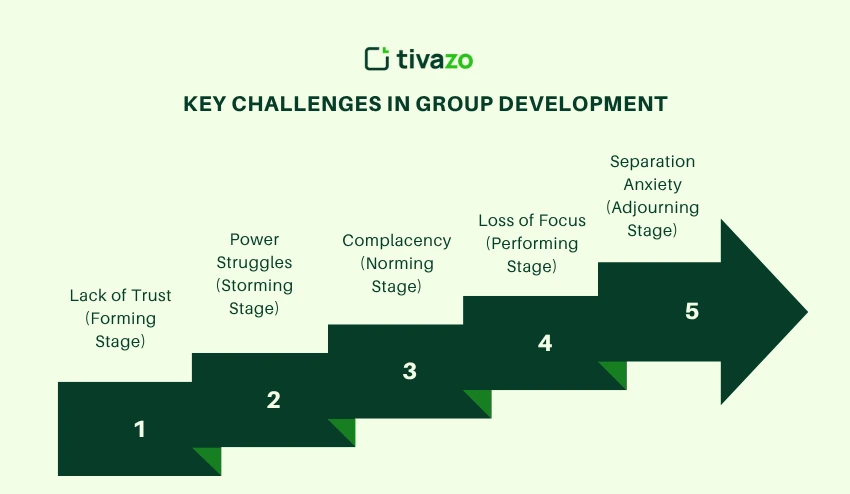
1. Lack of Trust (Forming Stage):
Team members may be reluctant to share ideas. Help build trust at the outset, and establishing team-building exercises as well as written agreements will help generate an environment where expectations for collaboration are clear.
2. Power Struggles (Storming Stage):
Conflict will arise as team members test their roles. Tackle these issues directly by facilitating a discussion that helps move the team toward resolution.
3. Complacency (Norming Stage):
Teams become complacent and stop chasing improvement. Foster scaffolding for continuous learning, and give constructive feedback.
4. Loss of Focus (Performing Stage):
Even teams at the high-performing level can lose focus on their priorities. It is important to inspire the team by reconnecting the team’s work to a larger goal and helping the team to acknowledge all progress being made.
5. Separation Anxiety (Adjourning Stage):
The team might feel a sense of loss when their team is over. Celebrate the team’s accomplishments and give credit to each member to create a positive closure.
How to Guide Your Team Through the 5 Stages of Group Development
Guiding your team through the 5 Stages of Group Development is not simply knowing the stages; it involves knowing as a leader to lead intentionally and to be proactive in guiding the team. As a leader, your role changes as the team progresses through these stages, and you need to have strategies that will guide the team through challenges and continue to build momentum toward success. Here are 4 strategies that are central to helping teams be successful in every stage of development:
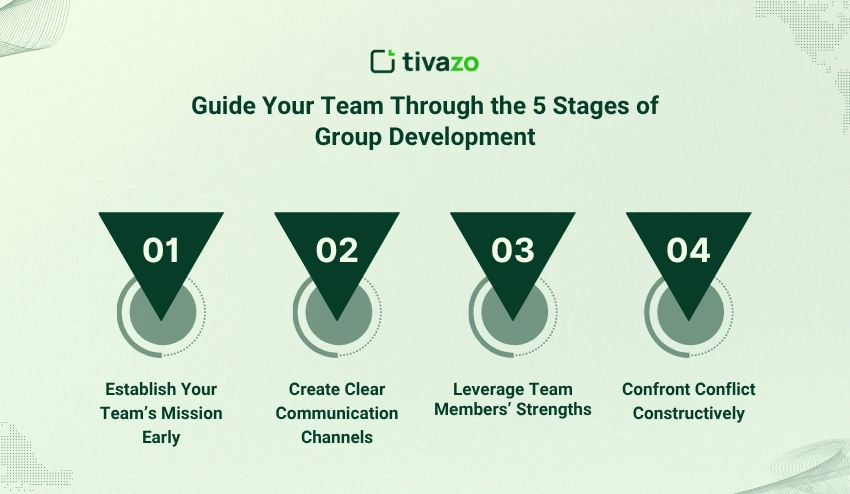
1. Establish Your Team’s Mission Early:
Crafting the team’s mission statement and project goals will help the team stay on task, especially during the forming and storming stages.
2. Create Clear Communication Channels:
Setting clear communication guidelines early can help prevent miscommunication and encourage transparency as the team continues to develop.
3. Leverage Team Members’ Strengths:
Learning about each individual’s strengths and utilizing those strengths to channel team member roles will improve productivity, especially as the team enters into the norming and performing stage.
4. Confront Conflict Constructively:
During the storming phase, creating an atmosphere of open. free discourse and conflict resolution can lead to longevity roles high-performing teams. Teams that demonstrate whether disagreements, performance objectives, tasks and team direction are likely to be higher performing teams for longer periods of time.
How to Measure Team Progress Through the 5 Stages of Group Development
As a leader of a team, it is important to understand team advancement through the 5 Stages of Group Development. By understanding how your team is developing, you can adjust your leadership to support them on time. Periodic measurement also allows you to identify areas of the team’s development for improvement and can boost team morale by allowing them to see their forward progression. There are a few different ways to measure growth at each of the stages.
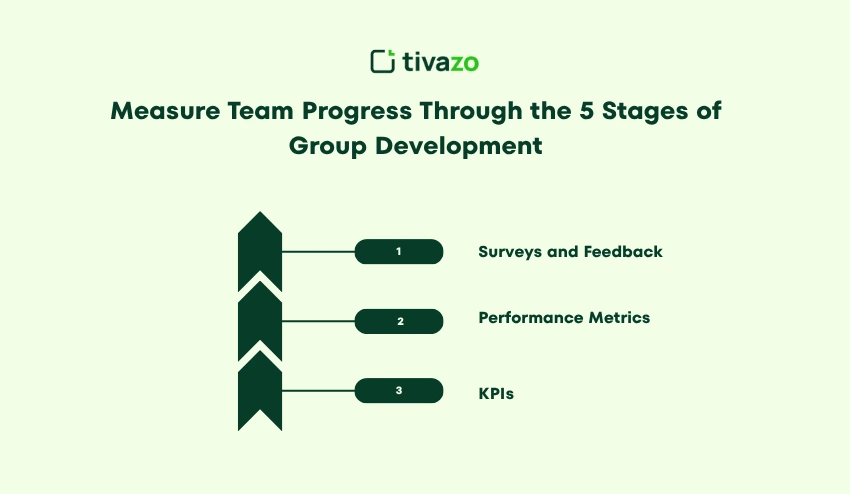
- Surveys and Feedback:
- Routine check-ins with team members about how they feel about trust and collaboration issues with the team.
- Performance Metrics:
- The monitoring team progresses toward milestones in project goals, and the group remains focused on the result.
- KPIs:
- Setting clear, measurable Key Performance Indicators (KPIs), such as how quickly the team resolves conflicts amongst themselves or the degree to which the team meets deadlines during the performing phase.
Regularly measuring the team’s development helps you identify when an individual team member or the team will require additional support, and contribute to providing some direction during the most critical moments of the 5 Stages of Group Development.
Why Understanding Group Development is Key to Team Success
Knowing the 5 Stages of Group Development doesn’t just stop with your knowledge of the theory – knowing where your team currently is, and what stage they are in works for you as the team leader to provide a type of value-added support and guidance to aid a smooth transition to the next stage.
When teams learn to navigate through the stages of team group development, you will notice a rise in collaboration, communication and double productivity as they are moving through their stage. With this knowledge, it equips you as the leader to manage and lead the group in a positive way toward success.
Final Thoughts: Leading Your Team to Success
The 5 stages of Group Development produce a path to an action-based plan to create and lead a high-performing team. By being aware of the individualized challenges the group experiences at each development stage, you will crash the course toward their goals, and a high level of success! Whether it is through a smaller team project, or a cross-functional as manager of the department, this model creates structure and expectations of success throughout the group development stages.



